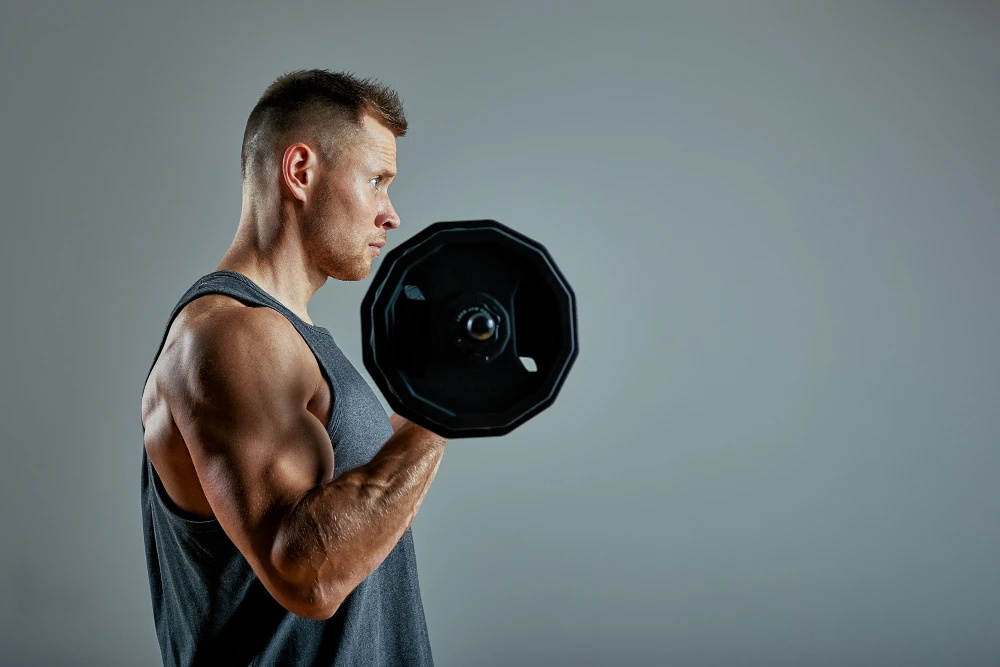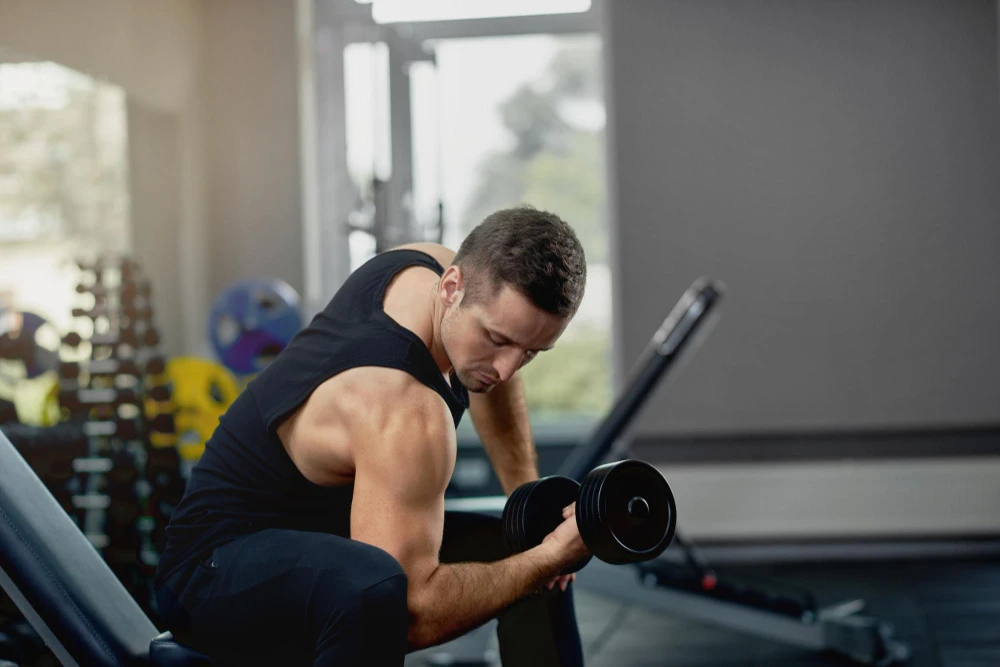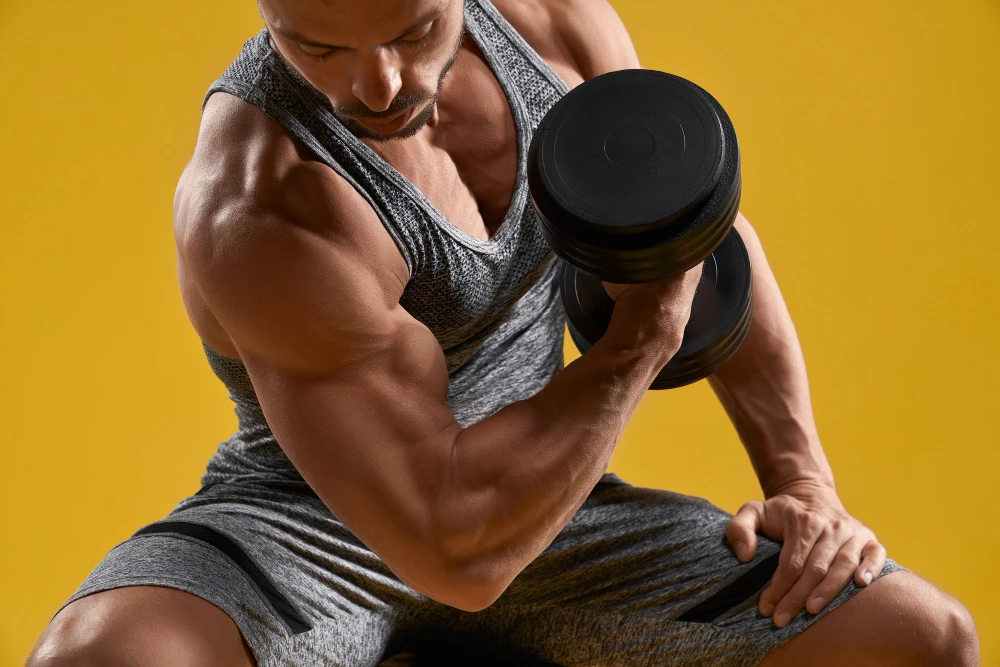In this blog, we will cover everything from the basics of bicep curl exercises to innovative variations that will challenge your arm muscles. We will discuss the benefits of different types of dumbbell and barbell bicep curls, chin-ups, forearm workouts, triceps workouts, and even reps and sets guidelines for optimum results. Additionally, we’ll cover common mistakes to avoid while doing these exercises and top tips to improve your form.
What are Bicep Curl Exercises?
For bigger biceps, try incorporating Bicep Curl Exercises into your arm day routine. Stand with feet shoulder-width apart, holding a pair of dumbbells or a barbell with palms facing up for an underhand grip. Keep your torso still as you curl the weight towards your shoulders with elbow flexion. Try incline dumbbell curls for a greater stretch in the long head of the bicep or drag curls for peak contraction in the short head. Zottman curls target both biceps and forearms enhancing grip strength. Avoid overextending elbows and start slow to ensure full range of motion for optimal results.
How to Perform Bicep Curls Exercises?
To perform bicep curls, hold a pair of dumbbells with an underhand grip and stand with your feet shoulder-width apart. Lift the weights towards your shoulders while keeping your elbows close to your body and maintaining constant tension in your biceps throughout the range of motion. Pause for a second at the top of the movement before lowering the weights back down to the starting position. Remember to incorporate variations like incline dumbbell curls, hammer curls, and preacher curls into your biceps workout routine.

Benefits of Bicep Curl Exercises
Bicep curl exercises offer several benefits for your overall fitness and strength development. Here are some of the key benefits of including bicep curls in your workout routine:
- Bicep muscle development: Bicep curls primarily target the bicep muscles, specifically the biceps brachii, which is the large muscle at the front of your upper arm. Regularly performing bicep curls can help strengthen and tone your biceps, leading to increased muscle mass and definition.
- Improved upper body strength: Strong biceps are essential for many everyday activities that involve pulling, lifting, or carrying objects. By strengthening your biceps through curl exercises, you enhance your overall upper body strength, making it easier to perform tasks like lifting heavy objects or pulling yourself up.
- Functional fitness: Bicep curls are considered a compound exercise as they engage not only the biceps but also several other muscles, including the forearms, brachialis, and brachioradialis. This functional approach to training mimics real-life movements, making your muscles and joints more prepared for daily activities and sports.
- Enhanced aesthetics: Well-developed biceps are often associated with an aesthetically pleasing physique. By incorporating bicep curls into your workout routine, you can increase the size and definition of your biceps, contributing to a more muscular and toned appearance.
- Joint stability: Bicep curls engage the muscles around your elbows, promoting joint stability and reducing the risk of injury. Strengthening the muscles in this area can be particularly beneficial if you participate in sports or activities that involve repetitive arm movements or lifting.
- Versatility and accessibility: Bicep curls can be performed using various equipment options, such as dumbbells, barbells, resistance bands, or even bodyweight exercises like chin-ups or inverted rows. This versatility allows you to choose the equipment that suits your preferences and the resources available to you, making bicep curls accessible to a wide range of individuals.
- Increased calorie burn: While bicep curls primarily target the biceps, they also recruit other muscles in your body, such as the core and stabilizer muscles, which can increase your overall calorie burn during the exercise. This can contribute to weight management and fat loss when combined with a well-rounded exercise program and proper nutrition.
Remember that incorporating bicep curls into your workout routine should be part of a comprehensive training plan that includes exercises for other muscle groups as well. It’s important to maintain balance and work on your entire body for optimal strength and fitness.
Bicep Curl Exercises Variations to Challenge Your Arm Muscles
There are many different bicep curl variations that you can do to challenge your arm muscles. Here are a few of the most popular:
- Dumbbell bicep curl: This is the classic bicep curl variation. To do it, stand with your feet shoulder-width apart and hold a dumbbell in each hand with your palms facing up. Slowly curl the dumbbells up towards your shoulders, keeping your elbows close to your sides. Lower the dumbbells back down to the starting position and repeat.
- Hammer curl: This variation is similar to the dumbbell bicep curl, but with one key difference: your palms face each other throughout the movement. To do a hammer curl, hold a dumbbell in each hand with your palms facing each other. Slowly curl the dumbbells up towards your shoulders, keeping your elbows close to your sides. Lower the dumbbells back down to the starting position and repeat.
- Preacher curl: This variation is done with a preacher bench. To do a preacher curl, sit on the preacher bench with your feet flat on the floor and your back against the pad. Hold a dumbbell in each hand with your palms facing up. Slowly curl the dumbbells up towards your shoulders, keeping your elbows on the pad. Lower the dumbbells back down to the starting position and repeat.
- Incline dumbbell curl: This variation is done on an incline bench. To do an incline dumbbell curl, set the incline bench to a 45-degree angle and lie back on the bench with your feet flat on the floor. Hold a dumbbell in each hand with your palms facing up. Slowly curl the dumbbells up towards your shoulders, keeping your elbows close to your sides. Lower the dumbbells back down to the starting position and repeat.
- Reverse curl: This variation is done with a supinated grip, which means that your palms face down throughout the movement. To do a reverse curl, hold a dumbbell in each hand with your palms facing down. Slowly curl the dumbbells up towards your shoulders, keeping your elbows close to your sides. Lower the dumbbells back down to the starting position and repeat.
These are just a few of the many different bicep curl variations that you can do. Experiment with different variations to find the ones that work best for you. As you get stronger, you can gradually increase the weight that you are using. Be sure to warm up before you start your workout and cool down afterwards. And most importantly, listen to your body and don’t push yourself too hard.

How Many Reps and Sets for Bicep Curls?
To get bigger biceps with bicep curl exercises, you must vary your rep ranges for muscle growth. For muscle endurance, aim for higher reps of 12-15 with lighter weights and shorter rest periods. For moderate reps of 8-12 for muscle growth, use heavier weights and longer rest intervals; lower reps of 4-6 with heavyweights can help with strength training. Gradually increase weight and intensity over time while maintaining proper form to challenge your muscles constantly. Follow Arnold Schwarzenegger‘s advice on YouTube by incorporating different curl variations like incline dumbbell curls and hammer curls into your biceps workout routine to build bigger biceps.
Common Mistakes While Doing Bicep Curl Exercises
Here are some common mistakes people make while doing bicep curls:
- Using too much weight. It’s important to use a weight that is challenging but that you can still control throughout the entire range of motion. If you’re using too much weight, you’re more likely to use momentum to help you lift the weight, which can lead to injury.
- Not using a full range of motion. It’s important to curl the weight all the way up to your shoulder and then all the way down to your starting position. If you don’t use a full range of motion, you’re not working your biceps as effectively.
- Swaying your elbows. Your elbows should stay in place throughout the entire curl. If you allow your elbows to move forward or backward, you’re taking the tension off of your biceps and putting it on your shoulders and elbows.
- Flexing your wrists. Your wrists should stay in a neutral position throughout the entire curl. If you flex your wrists, you’re putting unnecessary stress on your wrists and forearms.
- Cheating. There are a few different ways that people cheat during bicep curls. One way is to use momentum to help them lift the weight. Another way is to use their body weight to help them lift the weight. Cheating can lead to injury and it doesn’t help you build muscle effectively.
If you want to get the most out of your bicep curls, it’s important to avoid these common mistakes. Use a weight that is challenging but that you can still control, use a full range of motion, keep your elbows in place, keep your wrists in a neutral position, and don’t cheat.
Here are some additional tips for doing bicep curls:
- Warm up first. Before you start doing bicep curls, it’s important to warm up your muscles. This will help to prevent injury. You can warm up by doing some light cardio, such as jogging or biking, or by doing some dynamic stretches, such as arm circles and shoulder rolls.
- Focus on your form. It’s important to focus on your form when you’re doing bicep curls. This will help you to avoid injury and to get the most out of your workout.
- Take breaks. Don’t try to do too many bicep curls in one set. Take breaks between sets to allow your muscles to recover.
- Listen to your body. If you’re feeling pain, stop doing the exercise. It’s better to be safe than sorry.
By following these tips, you can make sure that you’re doing bicep curls safely and effectively.
Frequently Asked Questions
- Are Bicep Curls Only for Men?
Bicep curls are not exclusively for men. Both genders can perform this exercise to tone and strengthen their arms without worrying about bulky muscles. Adding variations can also help keep the workout challenging and prevent monotony.
- How Often Should I Do Bicep Curls?
The frequency of bicep curl workouts depends on fitness goals and overall routine. Building muscle mass may require 2-3 sessions weekly with rest days. Maintenance or toning may need once a week. Avoid overtraining to prevent injury and slow progress. Listen to your body and adjust the routine as necessary.
- Can Bicep Curls Help with Weight Loss?
While bicep curls can increase muscle strength, they are not a weight loss exercise. Weight loss requires a balanced diet and cardiovascular activity. However, building muscle boosts metabolism and helps burn calories. Bicep curls improve body composition and give a toned appearance.
Let’s Sum Up
In conclusion, bicep curl exercises are an essential part of any fitness routine that focuses on building strong and toned arms. By incorporating different variations of bicep curls, you can challenge your muscles in new ways and prevent plateauing. Remember to focus on proper form, slow and controlled movements, and incorporating variations to get the most out of your workouts. Don’t forget to also work on your forearm and triceps muscles for complete arm strength. And if you’re a beginner, start slow with lower weights and gradually increase reps and sets as you build strength.



